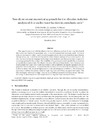Identificador persistente para citar o vincular este elemento:
https://accedacris.ulpgc.es/jspui/handle/10553/46941
| Título: | Two-dimensional numerical approach for the vibration isolation analysis of thin walled wave barriers in poroelastic soils | Otros títulos: | Enfoque numérico bidimensional para el análisis de aislamiento de vibraciones de barreras de onda de pared delgada en suelos poroelásticos | Autores/as: | Rodríguez Bordón, Jacob David Aznárez González, Juan José Maeso Fortuny, Orlando Francisco |
Clasificación UNESCO: | 330510 Cimientos 2201 Acústica 120601 Construcción de algoritmos 3305 Tecnología de la construcción |
Palabras clave: | Dual boundary element method BEM-FEM Rayleigh waves Soils Vibration analysis, et al. |
Fecha de publicación: | 2016 | Editor/a: | 0266-352X | Publicación seriada: | Computers and Geotechnics | Resumen: | This paper is concerned with the vibration isolation efficiency analysis of total or partially buried thin walled wave barriers in poroelastic soils. A two-dimensional time harmonic model that treats soils and structures in a direct way by combining appropriately the conventional Boundary Element Method (BEM), the Dual BEM (DBEM) and the Finite Element Method (FEM) is developed to this aim. The wave barriers are impinged by Rayleigh waves obtained fromBiot’s poroelasticity equations assuming a permeable free-surface. The suitability of the proposed model is justified by comparison with available previous results. The vibration isolation efficiency of three kinds ofwave barriers (open trench, simple wall, open trench-wall) in poroelastic soils is studied by varying their geometry, the soil properties and the frequency. It is found that the efficiency of these wave barriers behaves similarly to these in elastic soils, except for high porosities and small dissipation coefficients. The efficiency of open trench-wall barriers can be evaluated neglecting their walls if they are typical sheet piles. This does not happen with walls of bigger cross-sections, leading in general to efficiency losses. Likewise, increasing the burial depth to trench depth ratio has a negative impact on the efficiency. | URI: | https://accedacris.ulpgc.es/handle/10553/16342 | ISSN: | 0266-352X | DOI: | 10.1016/j.compgeo.2015.08.007 | Fuente: | Computers and Geotechnics [ISSN 0266-352X], v. 71, p. 168-179 | Derechos: | by-nc-nd |
| Colección: | Artículos |
Citas SCOPUSTM
22
actualizado el 08-jun-2025
Citas de WEB OF SCIENCETM
Citations
18
actualizado el 08-jun-2025
Visitas
145
actualizado el 25-oct-2025
Descargas
109
actualizado el 25-oct-2025
Google ScholarTM
Verifica
Altmetric
Comparte
Exporta metadatos
Los elementos en ULPGC accedaCRIS están protegidos por derechos de autor con todos los derechos reservados, a menos que se indique lo contrario.
